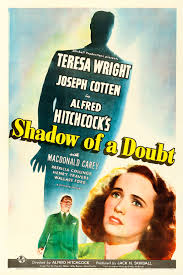
Charles Oakley (Joseph Cotton) learns from his landlady that there are two men that have been coming around looking for him. Charles decides it’s time to leave town and visit his sister in Santa Rosa, California. He boards a train.
In Santa Rosa Charlotte “Charlie” Newton (Teresa Wright) is moping around the house. All at once she thinks of her uncle Charles. When Charlie finds out that the uncle she was named after is arriving for a visit she is ecstatic. She believes there is a special bond between the two of them. Charles is her mother Emma’s (Patricia Collinge) younger brother. The day Charles arrives the entire family is at the train station to meet him. Along with Charlie is her father Joseph (Henry Travers), her mother, her younger sister Ann (Edna May Wonacott) and her younger brother Roger (Charles Bates).
At dinner everybody’s happy and Charles gives everyone presents. He gives Charlie an Emerald ring. Charlie finds someone’s initials in the ring. Charles blames the jeweler for selling him a used ring.
Not too long after that two men come to town posing as interviewers for what they call the national public survey about average families. Lame, but it works on Emma. But then everything works on Emma. The two men are Jack Graham (Macdonald Carey) and Fred Saunders (Wallace Ford). Charles refuses to have anything to do with them. Charlie tries to run interference for him.
It doesn’t take long for Charlie to figure out that the two men are really detectives. Jack comes clean and tells Charlie that her uncle is a suspect in the murder of at least three women. The murderer is known as “The Merry Widow Murderer”. He marries rich old widows and then kills them for their money.
Of course Charlie defends her uncle but bit by bit she begins to see that her uncle is harboring a hidden anger and hatred for life in general and women in particular. His manner begins to change. He is less and less the carefree uncle she thought he was and she begins to suspect that he really is a serial killer. Charlie is caught between her love for her uncle and her growing fondness for Jack. She wants Jack to be wrong and Charles to be the loving uncle she remembered, but that nagging suspicion won’t go away.
“Shadow of a Doubt” was released in 1943 and was directed by Alfred Hitchcock. It is a psychological thriller and a film noir. It was nominated for an Academy Award for best story. In 1991, the film was selected for preservation in the United States National Film Registry by the Library of Congress, being deemed "culturally, historically, or aesthetically significant". It is also reportedly Alfred Hitchcock's favorite of all of his films. It is supposed to be based on the true story of serial killer Earle Nelson, from the late 1920s, known as "the Gorilla Man".
Alfred Hitchcock’s cameo happens on the train to Santa Rosa. He has his back to the camera and is playing cards with the doctor and his wife.
The MacGuffin. In film a MacGuffin is a thing, an event or a plot devise that is important to the motivation of the characters or the advancement to the plot but is itself unimportant. Hitchcock uses MacGuffins all the time in his films. Some think there are no MacGuffins in “Shadow of a Doubt” but there are at least two; the newspaper which has the story of the serial killer and the Emerald ring that Charles gives to Charlie.
The story in the paper, as it is, has nothing to do with Charles, until he tries to hide it. The fact that he went to such trouble to destroy that part of the paper was a suspicious act. If Charlie’s father had read the article he wouldn’t have associated it with Charles. There was no reason to. But the fact that he hid it and Charlie found out what it was about made her suspicious of her uncle.
The Emerald ring that Charles gives to Charlie is just a ring. Charlie knows about the initials in it. When Charlie becomes suspicious of her uncle, and he knows she suspects him she gives the ring back to him. It’s when she recovers the ring and wears it in front of him that Charles decides he must take desperate action to try to protect himself.
The waltz tune that is referred to and where snippets of it are inserted throughout the film is Franz Lehár's "the Merry Widow." Waltz. It also refers back to the serial killers nick name “The Merry Widow Murderer”.
The film is extremely well crafted. It’s pure Hitchcock with suspense and intrigue. It is one of his lesser known films but, in my estimation, one of his better films.

